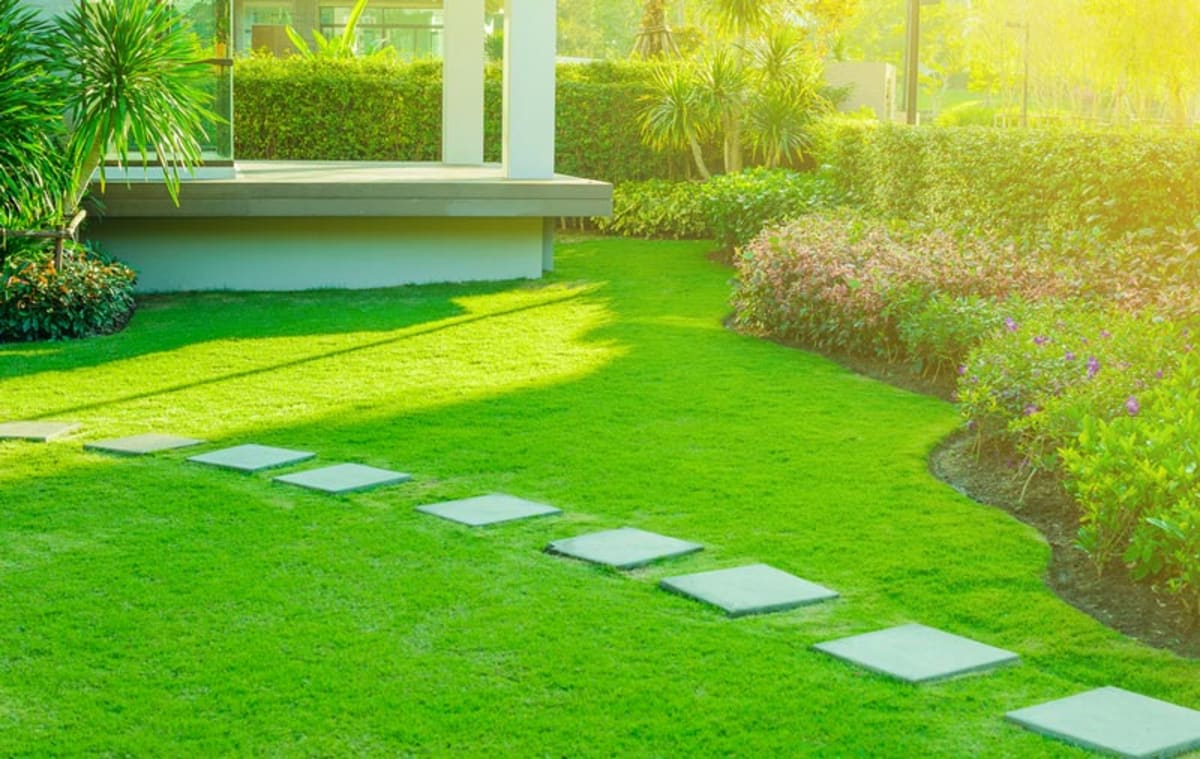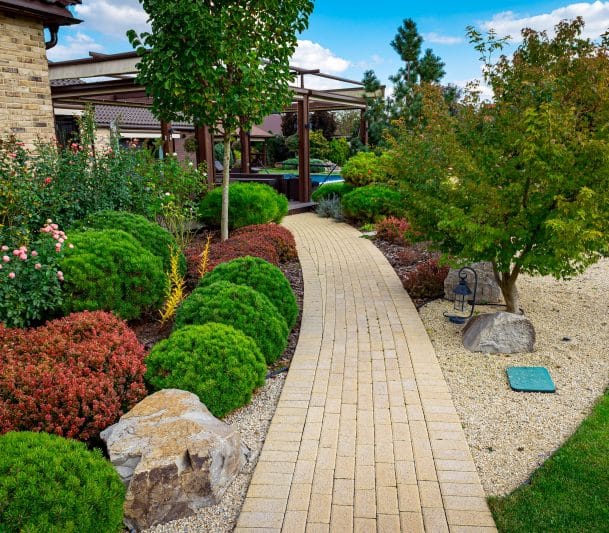Expert-approved landscaping strategies for long-lasting outdoor beauty
Recognizing the Comprehensive Range of Works in Specialist Landscaping Services
The comprehensive scope of specialist landscape design services includes a variety of basic elements. It consists of landscape style concepts, plant option, and hardscaping features. In addition, it addresses watering systems and upkeep methods. Each aspect plays a crucial duty in creating practical and cosmetically pleasing exterior rooms. Recognizing how these parts interact can disclose much regarding the art and science of landscaping. The journey right into this intricate field is simply beginning.
Landscape Design Principles
Reliable landscape style concepts are crucial for creating unified exterior areas that improve both visual charm and capability. These principles assist the plan of components within the landscape, making certain a cohesive visual experience. Secret components include balance, which distributes aesthetic weight evenly; percentage, which relates the size of different aspects to every other and the space; and unity, which creates a sense of integrity with consistent themes and products.
Focus guides attention to focal points, while rhythm establishes motion via repetition of design functions. The efficient usage of line can create paths and assist the eye via the landscape. In enhancement, comprehending the site's topography, climate, and existing attributes is crucial for assimilation with the surrounding atmosphere. By adhering to these fundamental principles, landscape designers can craft areas that not just look enticing but likewise offer their desired purpose, boosting the overall experience for users.
Plant Selection and Installation
In the domain name of expert landscaping, plant choice and installment play a vital duty in accomplishing a prospering garden - landscaping services. Emphasizing native plant benefits, seasonal considerations, and the particular soil and sunshine needs of each types ensures a lasting and visually pleasing landscape. Cautious planning in these locations not just enhances biodiversity but also advertises lasting environmental health and wellness
Native Plant Benefits
Why should property owners think about native plants for their landscape design jobs? Native plants offer various advantages that improve both aesthetic appeals and ecological sustainability. They are well-adapted to regional environments, calling for less water and upkeep contrasted to non-native species. This strength decreases the requirement for chemical fertilizers and chemicals, promoting a much healthier ecosystem. In addition, indigenous plants provide environment and food for neighborhood wild animals, including pollinators, which can boost biodiversity in houses. Their knowledge with local soil and climate condition also brings about far better growth prices and durability. By picking indigenous plants, home owners not only create visually attractive landscapes but likewise add to ecological conservation, making a favorable impact on their regional setting. Native plants represent a wise option for landscape design projects.
Seasonal Plant Considerations
House owners who have welcomed native plants in their landscape design can even more improve their outdoor areas by taking into consideration seasonal plant selections. By incorporating plants that thrive in certain seasons, they can develop visually appealing and vibrant landscapes throughout the year. Spring might introduce vivid flowers like tulips and daffodils, while summertime can showcase rich vegetation and vivid perennials. Fall presents a scheme of warm tones with goldenrods and asters, while winter season can be highlighted with evergreens and decorative turfs for texture. Expert landscaping companies usually recommend selecting plants that not just enhance existing indigenous varieties however additionally offer year-round passion and assistance local wild animals. This thoughtful approach to seasonal plant selection assures a continuously advancing and sustainable yard atmosphere.
Soil and Sunshine Requirements
Successful landscape design pivots on comprehending the details soil and sunlight requirements of plants. Various species prosper under varying conditions, needing a careful analysis of both variables during the choice procedure (landscaping services). Soil kinds, such as sandy, clay, or fertile, influence drainage, nutrition accessibility, and origin development. Furthermore, pH degrees can impact plant health, demanding soil screening to identify viability. Sunshine needs vary substantially; some plants grow completely sun, while others favor full or partial color. A specialist landscaping company thinks about these components to ensure peak development and visual allure. By lining up plant choices with the setting's details features, landscapes can achieve sustainability, resilience, and aesthetic consistency, inevitably leading to effective plant establishment and lasting maintenance
Hardscaping Attributes and Construction
While landscape design typically evokes photos of lush greenery and dynamic blossoms, hardscaping attributes play an important function in specifying exterior rooms. These components, that include outdoor patios, walkways, maintaining wall surfaces, and decorative stonework, provide framework and functionality to backyards and yards. Hardscaping utilizes materials such as concrete, rock, brick, and wood, permitting diverse designs that enhance the natural landscape.
The construction of hardscaping functions calls for mindful preparation and implementation to assure sturdiness and aesthetic charm. Experts assess website problems, drain, and spatial connections to develop natural outside atmospheres. Correct setup techniques are critical, as they prevent concerns like disintegration and changing over time.
Incorporating hardscaping not only improves the visual interest of a building yet likewise promotes exterior activities, making it a basic element of thorough landscaping services. Inevitably, thoughtful hardscaping contributes to both the functionality and charm of outdoor areas.
Watering Solutions and Water Management
Reliable irrigation systems and water monitoring are vital parts of professional landscape design, as they guarantee that plants receive the essential hydration for optimal development. These systems can vary from easy drip irrigation setups to advanced automated sprinkler systems, made to satisfy the certain demands of varied landscapes. Correct water management not only enhances water use, minimizing waste, yet also enhances plant health and wellness and decreases disease risks.
Landscaping specialists assess various elements, including soil type, plant types, and local climate, to establish customized watering remedies. In addition, including rain harvesting techniques can additionally improve sustainability and effectiveness (Read More). Routine maintenance of watering systems is necessary to keep capability and stop leakages, which can result in water loss and enhanced costs. Ultimately, a properly designed irrigation system plays a crucial role in protecting the visual appeal of outside spaces while advertising environmental stewardship within expert landscape design methods
Lawn Care and Upkeep Approaches
Grass care and maintenance approaches are basic for attaining a lavish, healthy lawn that improves the general landscape. These techniques incorporate numerous methods targeted at promoting optimal growth and aesthetic allure. Normal mowing is important, as it motivates thick, even growth while preventing weeds from establishing. Additionally, proper fertilizing supplies needed nutrients, with applications customized to the specific lawn type and soil conditions.
Watering techniques should concentrate on deep, seldom watering to motivate origin advancement, while aeration boosts dirt structure and advertises nutrition absorption. Pest and disease monitoring is likewise crucial; identifying issues early permits effective treatments that lessen damages.
Overseeding can rejuvenate damaged or thin grass, improving thickness and shade. By carrying out these targeted lawn care methods, landscaping experts can assure that lawns continue to be dynamic and check my source healthy and balanced throughout the periods, significantly adding to the overall charm of the property
Seasonal Landscape Treatment and Upkeep
As the seasons modification, appropriate landscape care comes to be essential for maintaining the wellness and appeal of outside rooms. Each period presents distinct difficulties and demands. In springtime, landscape professionals concentrate on trimming, planting, and fertilizing to urge development. Summertime needs regular watering, weed control, and bug management to shield freshly developed plants.
Fall requires the preparation of gardens for winter, including mulching, fallen leave removal, and the growing of light bulbs for the following springtime. Additionally, wintertime treatment includes safeguarding susceptible plants from frost and guaranteeing that hardscapes are useful and secure.
Throughout the year, seasonal landscape upkeep guarantees that exterior locations remain healthy and aesthetically attractive. Professional services can offer tailored upkeep strategies that adapt to the certain requirements of each season, enabling property proprietors to delight in vivid landscapes year-round. On the whole, seasonal treatment is a vital facet of professional landscape design that promotes durability and visual value.
Lasting Landscaping Practices
A growing variety of homeowner are welcoming sustainable landscape design techniques to develop eco friendly exterior rooms. These practices concentrate on saving sources, enhancing biodiversity, and minimizing ecological effect. Indigenous plants are commonly selected for their low tide demands and compatibility with regional communities, lowering the requirement for chemical fertilizers and chemicals. Rain gardens and permeable paving are utilized to handle stormwater runoff, advertising groundwater recharge and lowering erosion.
Sustainable landscaping includes organic horticulture strategies that prioritize soil health and promote natural insect control. Efficient irrigation systems, such as drip watering and rain harvesting, help enhance water use. Additionally, landscape designers progressively support for making use of recycled products, such as recovered timber and stones, to minimize waste. By adopting these sustainable methods, homeowner not only add to environmental conservation however likewise create visually pleasing settings that can love marginal upkeep.
Often Asked Questions
Just how Long Does a Landscaping Task Typically Require To Complete?
Generally, a landscaping project can take anywhere from a couple of days to a number of weeks to complete, depending on the job's intricacy, design, and size needs. Read More. Elements such as climate and resource availability likewise influence timelines
What Aspects Impact the Price of Landscaping Services?
Various factors affect landscape design service prices, including task size, style complexity, worldly top quality, labor expenses, geographic place, and seasonal need. Each component adds uniquely to the total financial needs of a landscape design project.
Are Landscaping Provider Available Year-Round?
Landscaping services are typically offered year-round, although availability might differ based on area, seasonal climate condition, and specific solution offerings. Some services could be restricted throughout extreme climate or off-peak seasons.
Do Landscaping Firms Deal Service Warranties on Their Job?

Can I Style My Landscape Without Expert Assist?
Yes, individuals can create their landscapes without specialist assistance. However, they might lack knowledge in plant option, design, and ecological factors to consider, potentially resulting in much less efficient layouts that can call for costly changes later.
